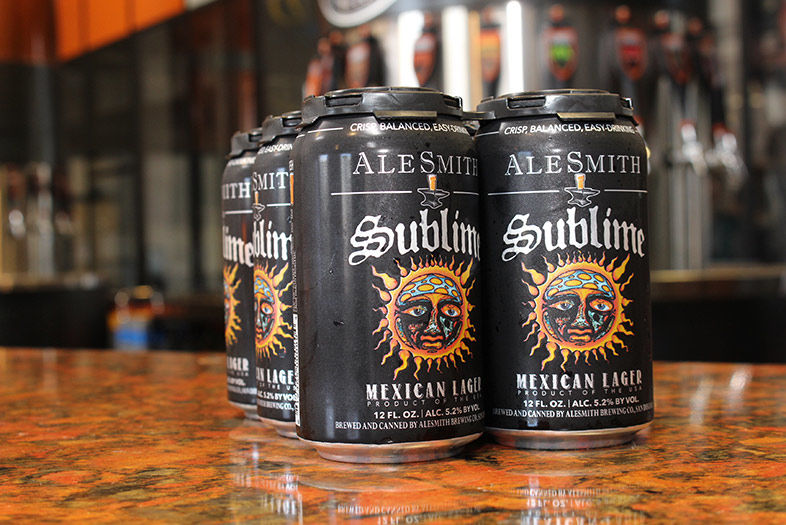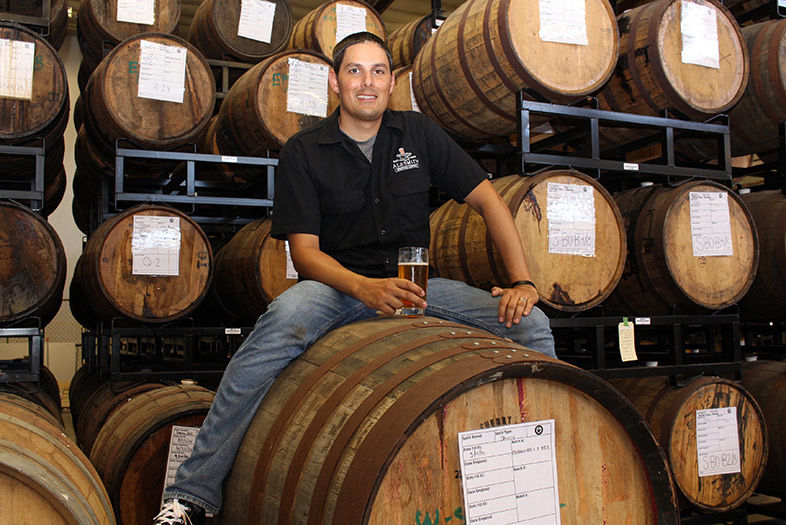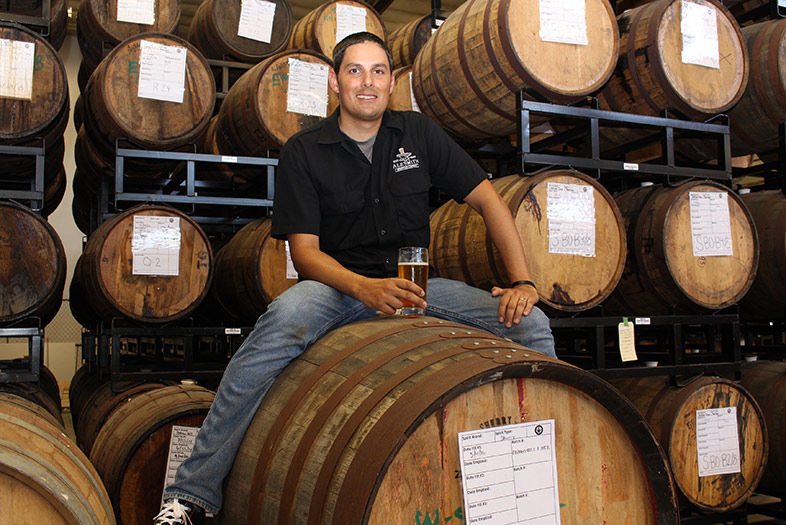Most pro brewers will tell you that the biggest challenge of their business is not the making of good beer; it’s the prudent management of growth. Over the course of the past five years or so, few breweries in San Diego have managed to grow as dramatically (or as prudently) as AleSmith. Owner Peter Zien has always been steadfast about keeping his company’s growth expectations reasonable; he’s allowed the business to expand organically instead of being ruled by some artificial boardroom cash flow projection.
Today, AleSmith is a market leader in many ways. Its core brands—Speedway Stout, Old Numbskull, IPA, AleSmith X, Horny Devil, and .394 Pale Ale—are all considered to be some of the finest examples of their styles available anywhere. AleSmith’s Miramar production facility has become a virtual Disneyland of craft beer; it’s not only one of San Diego’s largest (and most interesting) tasting rooms, it also houses the Tony Gwynn Museum and a Prohibition-inspired barrel room called Anvil & Stave where patrons can taste unique barrel-aged blends and even blend some of their own.
Head Brewer Ryan Crisp has been with AleSmith since the early days on Cabot Drive, and he’s seen the company expand in almost every way: More staff, more space, more equipment, more beer, and more reach than ever before. Sipping on a glass of Mt. Crushmore—a totally chuggable cream ale—I sat down to talk with Ryan about the challenges of scaling up, working with technology, and what it’s been like being a part of one of San Diego’s happiest success stories.
You’ve been with AleSmith a long time already. What’s the total at this point?
This month it’s 11 years. I was the fifth employee when I started. I started with cleaning tanks.
Had you been a homebrewer before that?
Yes. I’d been a homebrewer and Melody [my wife] had gotten a job at Karl Strauss. So we were visiting different breweries to get a feel for the market. I was only 21 at the time, so I hadn’t even had a chance to go to most of the breweries before that point, even though there were only like 15 or 20 of them back then.
Obviously, you’ve seen lots of major changes in this company over the years. When you look back over those early days, what are some of the things you feel are most different now?
Well, back then, when we were that size, we all had an interest in seeing AleSmith become something more. It was just a matter of how to make that happen. We were just a bunch of homebrewers. The biggest change we’ve seen, obviously, is moving to this facility and working on an automated system. Those things were fundamental changes for us coming from where we came from. Those changes ultimately made our beers better and made us safer and more efficient. But managing our growth through that transition has been our biggest challenge. It’s not just about all the new people and all the new equipment, it’s about the amount of new things we have to deal with so quickly. You’re always chasing your tail. You’re hiring someone to fill a job and already you need two more people in that department. When we moved here we had less than 20 people and now we have more than 65. We also have 15 or so open positions, so we’re still growing, we’re still hiring, and we’re developing a sales team, which we never had at Cabot. So we are still learning a lot about what it means to be a “grown-up” company.
What were some of the key strategies you needed to have to scale AleSmith up from the small facility to such a large one?
I think the first thing was just convincing ourselves that we could do it—that we could pull it off. We didn’t want to overcommit to something and then come in here and have it be a disaster. The other thing was, with such a small team, we didn’t have any engineers or highly technical people to help manage the transition. We also had millions of dollars of new equipment coming in and we had to adapt our recipes to that, so that was a big project. It took a few years of my time.
What were the biggest challenges to scaling up from a 30-barrel system to the 80-barrel automated system you now use? How do you do it so the beers wind up tasting the same?
It’s not just a matter of changing one aspect of the process. Everything was different from what we had before—from the way the malt is handled, to how the water is heated; everything. We worked with a lot of experienced vendors who have a lot of experience scaling different processes up. So, for us, it was about taking what we were doing manually and finding a way to replicate it on an automated system.
Did those vendors taste your beers, for example, and tell you how to make it taste like that?
The flavor matching was more on us. We knew a little about it from before, when we scaled from a 15-barrel system to a 30-barrel system. And we knew some of the challenges. From there it was mostly a matter of trying things and adjusting as we went.
Do you feel like you’ve ultimately landed in a place where the beers are better than they were at Cabot?
I do. It’s actually something we often talk about amongst ourselves. I feel that there’s kind of a refinement and a cleanliness to the beers that we make here. And I think a lot of that is because we’ve been able to make our processes more consistent; the automation does help with that. It allows you to really control what you’re doing before you even try it once. So we can make a new beer, never even having brewed a test batch of it—we could brew 100 barrels of it—and it’ll come out the way we want it to come out.

Have a Beer with AleSmith’s Head Brewer Ryan Crisp
AleSmith’s newest beer is a Mexican Lager that was done as a collaboration with the band members of Sublime. | Photo: Bruce Glassman
What do you say to the romantics who think automated systems are not as true to the “craft” ideal and believe brewers should be hauling bags of grain on their shoulders and stirring ingredients by hand?
I’ve heard that. Personally, I don’t know what’s so romantic about climbing into an open fermenter and scrubbing it. I feel that I’m much more in tune with the process of brewing on this equipment. There’s so much more detail and science you have to understand to be able to design a recipe on this kind of system. Before, we were kind of shooting from the hip. We were adding things—stirring it, pumping it. It was very simple and we got to the point where we could do it really well, but it wasn’t as consistent as it is now and it wasn’t as efficient.
Are there beers you’ve developed here that you feel you couldn’t have done on the old system?
I feel like we get a different kind of character with some of our hoppy beers here. We’ve also started making a lot of lagers here, which is something we hadn’t done a lot of before. I think our system has helped a lot with that, because with those beers, we’re looking for a really clean and refined finished product.
My sense is that .394 kind of propelled AleSmith into a whole new universe. It didn’t change what you were doing, but—to me—it was such a blockbuster type beer—such a “mainstream” beer. Do you feel it changed the trajectory of the brewing program to some extent?
We didn’t know what we had when we first made it, but it really did take off; especially this year and the end of last year. It’s now our best-selling beer by far [previously the bestseller was IPA] and a lot of that is local sales [75% of AleSmith’s sales are local]. So we were always the beer that craft drinkers knew about, but the people on the outside of that world didn’t know us. Because .394 is so accessible it has allowed us to reach a different demographic and it’s given us access to different kinds of retail locations. It raised the level for all of our beers and for the company as a whole.
Are there other beers you’ve done here that you feel have opened up new doors for you?
The beer we made with Sublime—the Mexican Lager—that’s something that’s a little bit different for us. We’ve done a pilsner before, but this style is something new. Most Mexican lagers are patterned on a very light and easy-to-drink type of style. Ours is a little bit darker and it’s got a little more malt flavor, but you can still drink it easily. It strikes a nice balance that way. And I think it’s going to be really popular. I know our employees love it.
What are some of the things you feel a big brewery needs to do to stay relevant and interesting over the long term?
That’s the question, isn’t it? It’s the hard part and we talk about that a lot. How to balance doing things that are new, innovative, and interesting, while also maintaining our passion for classic styles. Well, we maintain a strong portfolio—beers like .394 aren’t going to go anywhere—but we try to add new things in as well. We probably do about 40 different beers every year, and a lot of them are simple draft beers that we sell just locally. We do have some new things coming up next year that I think will be pretty exciting.
You also have the Anvil & Stave component, which provides some unique and interesting beers on a regular basis.
Yeah. We love it. It’s allowed us to offer a bunch of our barrel-aged beers on draft and also to get one-off funky barrels and roll them through there—like, we had some gin barrels and some salt-brined barrels—and we can do small amounts for draft and we can blend as well. Our brewers do a special blend every month. I think the blending aspect is really cool because it takes those classic beers that we love and makes them even more interesting and different.
So, you’ve got Anvil & Stave, the Gwynn Museum, a brand new mezzanine coming to the tasting room, and the soon-to-be-operational CheeseSmith facility. What else could you possibly do here?
Well, Peter loves making mustards, breads, pickling things, and roasting coffee. We do use a lot of coffee here, so we might do something with that. So we’ll see. Never say never, right?

Have a Beer with AleSmith’s Head Brewer Ryan Crisp
PARTNER CONTENT
Ryan Crisp is AleSmith’s head brewer. | Photo: Bruce Glassman


















